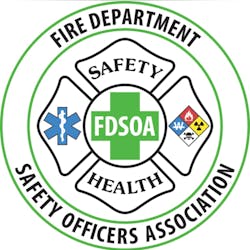FDSOA Releases COVID-19 Safety Recommendations
The Fire Department Safety Officers Association (FDSOA) recommends implementing the following actions during the COVID-19 pandemic, if your department has not already:
- Screen personnel when they are coming on duty and then 12 hours later (24-hour shifts). If they have 100.4°F temperature or signs/symptoms of illness, send them home. Ensure your Infection Control Officer is notified, if any personnel are identified.
Some agencies are just using fever/chills and signs/symptoms of a respiratory illness (dyspnea, cough), another agency is saying - If they have two or more of the following: muscle aches and pain; nonproductive cough; sore throat; runny nose; nausea, send them home.
**Check with your medical directors/hospital systems, etc. for local recommendations.**
- Develop a maximum and minimum staffing level plan per type of apparatus for volunteer companies.
- Limit the number of members having patient contact to essential personnel only.
- Ensure personnel know when and how to don the appropriate PPE. Ensure supplies of PPE are available and create a reuse protocol for N95 masks based on CDC recommendations to manage limited supplies.
- Have your communications center implement a flu/COVID-19 screening process on calls. This information can be sent to responders while en route to the call so they can don their PPE prior to making patient contact.
- When personnel respond to emergencies, have them slow down and assess the scene before entering. Sometimes the unknowns can be patients with flu-like symptoms. This will allow them to stop and don PPE prior to entering the building.
- A mask should be placed on patients you are concerned about potentially having the illness.
- Limit personnel entering the hospital at time of transfer of care and other needs to visit the hospital.
- Allow units to temporarily go out of service to clean their unit, uniform and shower if they run a patient with flu/COVID-19 signs and symptoms. Ensure an exposure form has been completed for tracking purposes.
- If personnel are off duty they should not be in the station/admin facilities.
- Eliminate in-person, non-essential meetings. Use teleconferencing if possible. Promote telecommuting for non-essential personnel.
- Utilize social distancing while on duty.
- Eliminate social functions (bingo, pancake breakfast, company meetings, allowing the public into the station for station tours).
- If there isn’t a plan for reductions in workforce, then work to create one--this should be part of your COOP.
- Have a plan to quarantine personnel if directed (where will they go, what leave status will they be placed on, food, etc.). For volunteer companies with live-ins, have a plan to relocate them if they become ill.
- Continue to promote hygiene practices and cleaning of works spaces.
- Increase the frequency of wiping down door handles and all surfaces at the station and in the apparatus. The virus can live on a surface for up to 3 days. Make sure your EVT mechanics are aware of the need to clean all apparatus.
- Ensure that there is a plan if personnel test positive for COVID-19, i.e., a plan for communication and potential coverage during the quarantine period.
- Cease the use of humidifiers in stations/bunk rooms.
- With all the disaster declarations, work with budget/procurement personnel to track all purchases such as PPE for possible reimbursement.
- Work to have “one voice” sending information to the department. All formal messages/direction on COVID-19 should come from one person. This way it avoids duplication and possibly contradictive information. Reference of information should be from a reputable and consistent source, i.e., CDC.
- If your organization hasn’t set up an IMT for this situation, recommend one be established. If one is set up, make sure you have an HSO/ISO representative on it.
About the FDSOA
The Fire Department Safety Officers Association (FDSOA) was established in 1989 as a non-profit association, incorporated in Massachusetts. In 2013, the offices moved to Michigan. Its mission is to promote safety standards and practices in the fire, rescue and emergency services community. The association is led by a volunteer board of directors and has a small staff to handle the day-to-day operations. The association is dedicated to the issues that affect the critical role of the safety officer in protecting and promoting the safety and health responsibilities of fire departments, communities and first responders. FDSOA works to helps fire departments achieve proficiency and promote the recognition of training, skills and a secure future. In May 2016, FDSOA won the Paul S. Sarbanes Fire Service Safety Leadership Award for its work over 28 years, “as an organization fully dedicated to the health and safety of the nation’s firefighters.”
